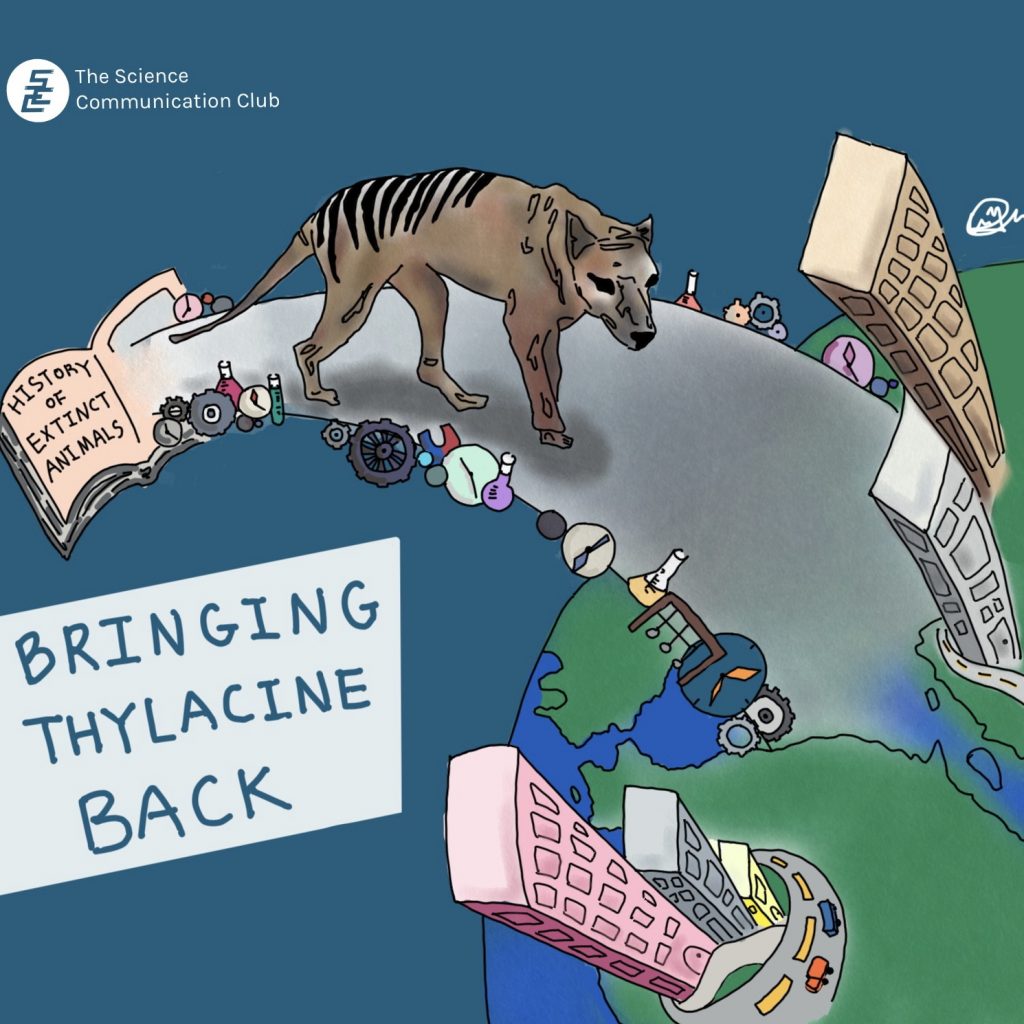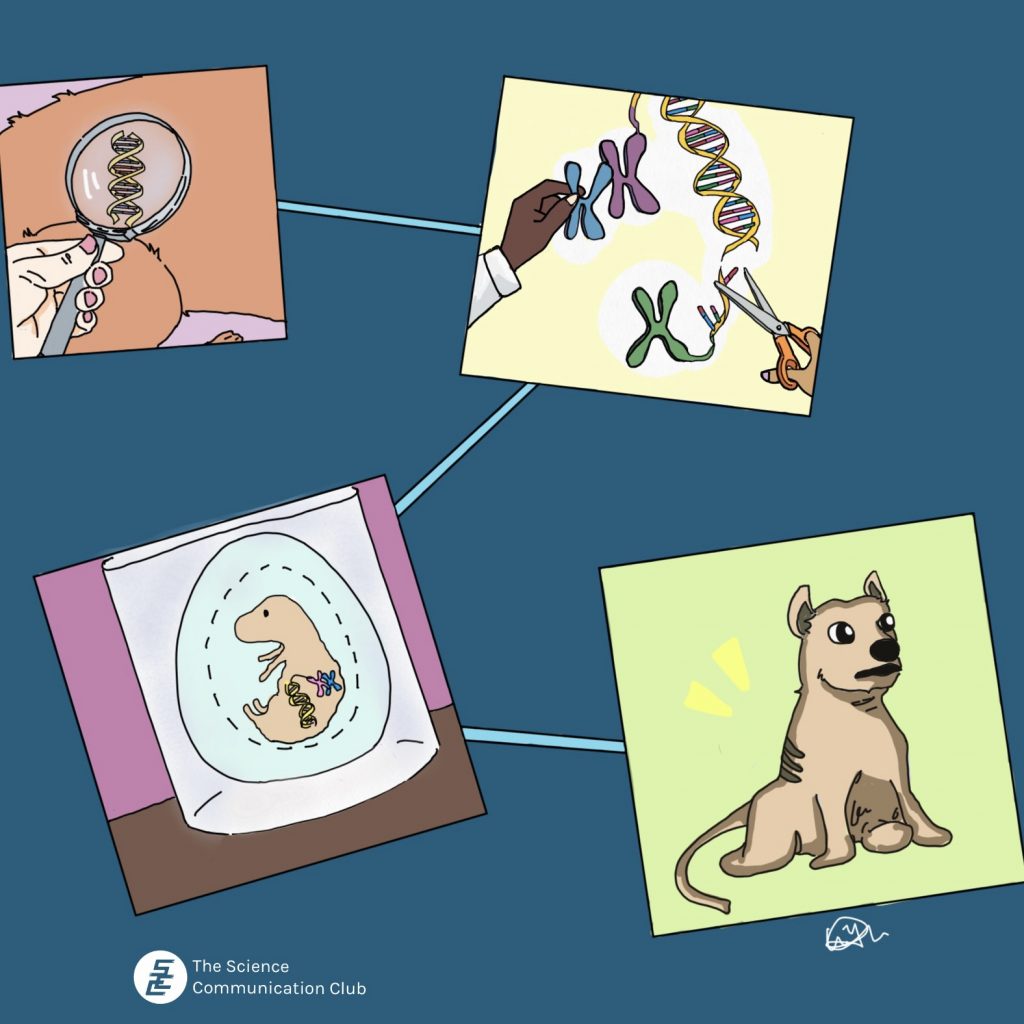
Written by Sabrina Zaidi
Illustrated by Haely Oh
When I first watched Jurassic Park as a kid, I wasn’t at all worried about dinosaurs becoming a problem in the future. It was just science fiction after all, surely we can’t bring an extinct animal back to life! As time passed, the movie started becoming more of a cautionary tale and less fictional as the progress of scientific advancements continued to accelerate. In a world with climbing extinction rates yet remarkable technological innovations, it seems that the resurrection of extinct species is the solution to the extinction problem, but is it really a solution free of consequences?
Scientists have already begun the process of bringing extinct animals back to life. A few months ago, bioengineering company Colossal announced their plans to partner with the TIGRR (Thylacine Integrated Genetic Restoration Research) lab to resurrect the extinct thylacine.1 Also known as the Tasmanian tiger or Tasmanian wolf, this unique dog-like marsupial roamed Australia as an apex predator until its extinction due to over-hunting, habitat destruction, and introduced-disease.2,3 The last thylacine died in captivity at the Beaumaris Zoo in 1936, officially marking the extinction of the species.1 Being an apex predator at the top of its food chain, the thylacine helped maintain their ecosystem through predator-prey interactions by keeping populations in check and influencing species’ interactions.1 When a top predator goes extinct and is removed from the ecosystem, it can lead to a series of detrimental effects moving down the food chain.4 This phenomenon is called trophic downgrading, which may have happened after the thylacine was driven to extinction.1 Trophic downgrading can ultimately lead to increased problems pertaining to wildfires, disease, carbon sequestration, invasive species, and more.4
Combatting the trophic downgrade effect is where de-extinction comes in. By reintroducing the thylacine back into its natural environment, it could help enrich the ecosystem and allow for healthier populations to flourish.1 This may sound simple in concept, but the execution of the process is far from easy. Because the thylacine only went extinct relatively recently, researchers from the TIGRR lab were able to access a 108-year-old thylacine corpse specimen and sequenced its DNA in 2018. Later, this information helped them determine the closest living relatives of the species.1 In the future, the researchers will use computational biology to connect genes to physical traits that would result in a ‘thylacine-like’ outcome.1 Thylacine genes will then be used in gene editing techniques such as CRISPR, where the genetic information from the cell hosting the genome will be inserted into an egg and begin embryonic growth.1 The embryo will eventually be placed in a surrogate and gestate for 42 days until being ready to face the modern world.1 After its birth, the thylacine will be raised with the help of many zoos and establishments to create a healthy population and ensure a safe rewilding process in Tasmania.1

As with most natural innovations, it’s impossible for such grand ambitions to exist without controversy. Critics of the plan say that it’s largely a waste of money and resources that could instead be better spent on saving living endangered species.5 Conservationists fear that the introduction of de-extinction could draw attention and urgency away from the conservation of species that are currently alive, making it seem as though we can allow more species to go extinct with the chance to save them afterwards.6 Additional ethical concerns have been raised regarding whether Indigenous Australians have been consulted on this plan, due to the thylacine being a significant part of their culture, with special consideration for Tasmanian Aboriginal communities.6 Aside from these worries, there is also criticism that the plan can backfire or the thylacine populations will not be able to survive.6
Despite the potential pitfalls, many of those in favour of the de-extinction of the thylacine subscribe to the idea that humans caused their extinction, so humans should be the ones to fix it.5 There’s potential for de-extinction to improve the local ecosystem, and as researchers have stated, there’s a low chance for the population to perform poorly due to their native environment likely being able to effectively host the species.5 No one can deny how great it would be to see a living thylacine today, but where should we draw the line at making science fiction into a reality?
Sources:
- Thylacine. [accessed 2022 Oct 21]. https://colossal.com/thylacine/
- Thylacine. The Australian Museum. 2021 Jan 27 [accessed 2022 Oct 21]. https://australian.museum/learn/australia-over-time/extinct-animals/the-thylacine/
- Extinction of Thylacine. National Museum of Australia. 2022 Sep 21 [accessed 2022 Oct 21]. https://www.nma.gov.au/defining-moments/resources/extinction-of-thylacine
- Estes JA, Terborgh J, Brashares JS, Power ME, Berger J, Bond WJ, Carpenter SR, Essington TE, Holt RD, Jackson JB, et al. Trophic downgrading of Planet Earth. Science. 2011;333(6040):301–306. doi:10.1126/science.1205106
- Dean S. Should we bring back the thylacine? we asked 5 experts. The Conversation. 2022 Aug 17 [accessed 2022 Oct 21]. https://theconversation.com/should-we-bring-back-the-thylacine-we-asked-5-experts-188894
- Evans K. De-extinction company aims to resurrect the tasmanian tiger. Scientific American. 2022 Aug 16 [accessed 2022 Oct 21]. https://www.scientificamerican.com/article/de-extinction-company-aims-to-resurrect-the-tasmanian-tiger/